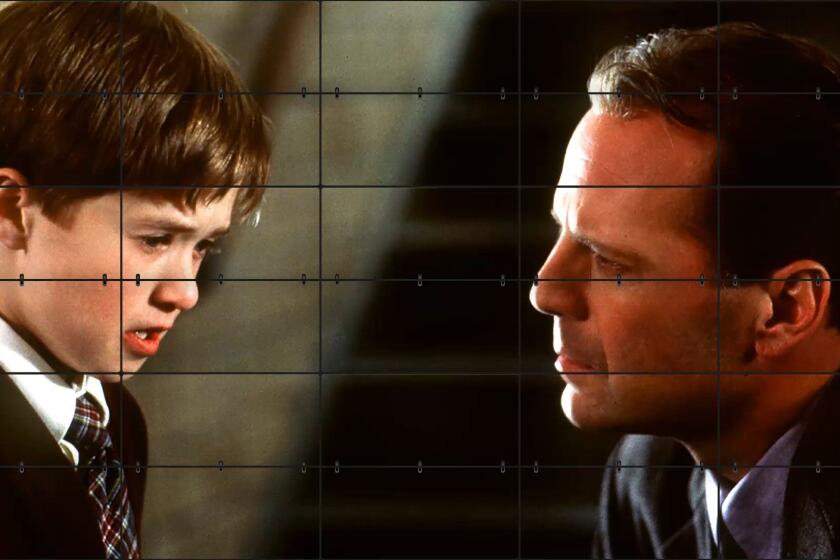Doug Liman hopes his wild loop means a hit with ‘Edge of Tomorrow’
In the phantasmagorial sci-fi epic “Edge of Tomorrow,” Tom Cruise finds himself encased in an 85-pound metal exoskeleton bristling with futuristic weaponry and confronted with a singularly intractable situation: a kill-and-be-killed conflict that repeats on indefinite loop.
Over and over he wages the same battle against marauding space invaders only to perish and discover himself mysteriously reincarnated, blessed with terrible new knowledge of his enemy as well as his own limitations as a hero.
“Live, die, repeat,” as the movie’s tag line goes.
Cruise’s predicament in the film, which hits theaters June 6, provides a nifty parallel for the career of Doug Liman, “Edge of Tomorrow’s” trailblazing yet bedeviling director. Over the last two decades, the filmmaker has condemned himself to a cycle of creative conflict he readily acknowledges follows a certain pattern, in the process alienating friends and creating powerful Hollywood enemies. On his most notorious movie productions, the director’s M.O. — dubbed “Limania” by some former collaborators — has stretched producers and studio heads to their breaking points and imperiled his ability to get work directing movies.
“It’s no secret that my process is a little bit loose and can be a little bit infuriating to a studio if they don’t know what they’re signing up for,” Liman says, letting his understatement hang in the air of his West Los Angeles production office.
All the while, however, the Manhattan-born Liman has continued to burnish a filmography distinguished by features that have become touchstones of their respective genres. Among them: 1996’s lounge-lizard dramedy “Swingers,” responsible for launching the careers of Vince Vaughn and Jon Favreau and injecting the phrase “You’re so money” into popular consciousness; “The Bourne Identity,” which grafted existential turmoil onto a Robert Ludlum spy thriller in 2002, and “Mr. & Mrs. Smith,” the romantic-action-comedy that first unleashed the entity known as Brangelina on the world in 2005.
“Edge of Tomorrow” appears set to follow in that line, boasting an impressive 92% “freshness” rating on the movie review aggregator RottenTomatoes.com and showing strong pre-release awareness across the globe for showcasing action veteran Cruise in a totally new light.
“It’s fun coming up with new ways to kill yourself,” Cruise says with a laugh. “I told the stunt guys, ‘Watch Wile E. Coyote cartoons. It’s not violent enough!’”
Moreover, Liman’s eclectic oeuvre goes some way to explaining why he chooses to view his latest effort — a $178-million popcorn movie that makes extensive use of green-screen technology and stars the most enduring action hero in moviedom — as an “independent film.” Even if that process of maintaining creative autonomy results in ruffling Hollywood’s feathers again and again.
“I never want to repeat myself,” Liman, 48, says of his body of work. “I can’t imagine anything else as upsetting as realizing I’m redoing something I did before. For some reason, when it comes to film, I’m very good at not repeating myself. Even though in the rest of my life, I’m constantly repeating my mistakes.”
Turbulent success
Before there was “Edge of Tomorrow,” there was “All You Need Is Kill,” a 2004 illustrated Japanese novella that follows an 18-year-old recruit in the United Defense Force who finds himself battling an alien race of superior beings called “mimics” that are besieging Earth. Caught in a “time loop” — the plot device seen in the 1993 Bill Murray comedy “Groundhog Day” — the soldier must change his fate one death at a time, improving as a warrior to beat the mimics and save the world.
Developed into a screenplay by the Hollywood production company 3 Arts Entertainment, Liman joined the project in 2010, with Cruise signing on a year later (the young recruit character now re-imagined as a cowardly middle-aged lieutenant colonel who has never experienced battle). About six months before cameras rolled in 2012, the Limania began in earnest.
With the movie’s coveted June release date staked out by its distributor Warner Bros. and a hefty nine-figure budget on the line, Liman says he discarded more than two-thirds of Dante Harper’s original script to rebuild the movie “from scratch.” A mere eight weeks before physical production began on “Edge of Tomorrow,” with screenwriter Christopher McQuarrie taking over from “X-Men: Days of Future Past” scribe Simon Kinberg, who had in turn taken over from sibling writers Jez and John-Henry Butterworth, the film was still without a final act that Liman found satisfactory.
As producers and studio bosses gnashed their teeth, the situation resulted in a testy exchange among Liman, Cruise and Emily Blunt (“The Five-Year Engagement,” “The Devil Wears Prada”), who costars as legendary commando Rita Vrataski — a character known as “full-metal bitch” for having killed 1,000 mimics in a single battle — who mentors Cruise’s reluctant hero.
“I was a little under pressure and I snapped,” Liman recalls. “And Emily said, ‘Easy, I’ve never made a movie like this before!’ I fired back, ‘Well, neither have I!’”
“The room sort of ground to a halt,” the director continues. “My producer Erwin Stoff told me later it was the most incredible thing he’d ever heard anyone say: The director telling the stars of the movie that, basically, he had no idea what he was doing.”
And this wasn’t just any director copping to making it up as he was going along. This was, after all, the guy who famously kept his “Bourne Identity” production crew on the clock after a day’s filming to light a forest outside of Prague so he could play paintball — whose production delays, disorganization, screaming fights with producers and a reported $10-million budget overrun on the $55-million “Bourne” compelled Liman to contemplate selling his director’s credit on EBay.
Thanks to that experience, Liman claims then-Universal Pictures Chairman Stacey Snider told him he was “never going to work again.” (The movie’s critical and commercial triumph, of course, dictated otherwise, launching a franchise of “Bourne” films that have combined to gross over $1.2 billion.)
Favreau, writer-star of Liman’s low-budget indie breakthrough “Swingers” — with whom the director forged a sibling-like bond during production — actively shunned Liman for years after he negotiated a $5.5-million distribution deal that enriched himself while effectively excluding Favreau from the profit sharing. Akiva Goldsman, a producer on “Mr. & Mrs. Smith,” described Liman — lanky and intense, possessed of cornflower blue eyes and what has been described as a “thousand-yard stare” — as “a madman” to The Times in 2005.
Exhibit A: When Fox attempted to rein in the director’s spiraling “Smith” budget (originally set at just over $100 million but which ballooned to $126 million), Liman used his own money to build a set inside his mother’s garage in upstate New York — and destroyed it with a hand grenade. Exhibit B: Liman commissioned screenwriter Kinberg to draft 40 or 50 different endings for the “Mr. & Mrs. Smith” script only to end up filming the original version.
Cruise, for his part, was aware of the director’s reputation, but insists he was in no way thrown by Liman’s flying-by-the-seat-of-his-pants admission.
“It didn’t faze me at all,” Cruise says. “Good. Whatever. There’s no doubt about this guy’s talent, no doubt about his taste and his commitment. And one of the ways Doug works, you’re developing the tone as you’re working.”
The star says he grew to respect the director’s process and supported him throughout the production — including “Edge of Tomorrow’s” less than auspicious start. The movie began filming without a finished script, an alarming but hardly unprecedented plight in Hollywood. And on the second day of principal photography, Liman demanded a total reshoot of everything filmed on Day 1, a move the director acknowledges had producers reaching for the Maalox Plus.
“Having produced so many films and worked with so many people, I admire and appreciate that Doug is that honest,” Cruise continues. “You can actually have real conversations. What I love about Doug is his relentless pursuit of making the best movie he can make.”
British actress Blunt puts a finer point on that character trait, praising Liman’s ability to present his unvarnished opinion absent any fear of provoking dissent in his ranks.
“He has no filter when it comes to being honest,” she says. “You can waste so much time with politeness and diplomacy on set. That’s what’s so refreshing about Doug. He’s honest when he’s not happy with something and very honest when he is happy with something. He’s confident enough to try anything and carve out new space for every moment that is in the movie.”
Managing the mania
Fearing precisely the kind of overages for which Liman has become renowned, producer Stoff demanded that the filming of “Edge of Tomorrow’s” signature set piece — humans storming the alien stronghold on France’s Normandy beach — take place on a massive set rather than any rented location. So against the director’s initial wishes, the production built a fully functioning beach — nicknamed “the Bitch” by cast and crew — at Warner Bros. Studios, Leavesden, a sprawling complex near London.
There Cruise, Blunt and a platoon of supporting cast members wearing cumbersome exoskeletons braved the damp chill of British winter, dodging explosions while harnessed to cranes by aerial wires. Blunt nearly broke her nose in a mishap involving a broadsword. The planned two-week shoot ended up stretching to nearly three months thanks to the director’s self-described “workshop-y” filming style. At the end of each day there, Liman (in full waterproof regalia) lined up with a row of extras to have the mud sprayed off them with a high-powered hose.
Stoff acknowledges that Liman’s approach to filmmaking supplied certain challenges. But unlike the director’s battles with Universal over “Bourne,” Stoff, Cruise and Warner Bros. all knew what they were getting into when Liman got the job. Hence, they made adjustments for his capriciousness and headed off the nasty surprises.
“It definitely is not the most calm-inducing experience to be facing the start date without a script. You have to have a cast-iron stomach,” Stoff says. “What made me hire Doug is, he has an ability to take a tried and true genre and find something completely new in it, push the familiar genre elements to the back and use the genre to explore something brand new and completely original.”
“I don’t need the studio coming down on me,” Liman says. “I make movies for me and posterity. I’m more scared of history than I am of the studio.”
For all the filmmaker’s talk, however, Liman says he grew unnerved when studio executives did not arrive on set to keep tabs on him, mistaking their faith in him for a total withdrawal of support.
“It’s easier knowing I’ve had this pressure on me before and I’ve made it through. But at the same time, this may be the one where I don’t make it through,” the director explains. “My friends say, ‘You’re only one or two bombs away from being unhireable.’ I am aware of that.”
Pondering his revelation to Blunt and Cruise — Liman’s “Can’t we all just acknowledge I’m in new territory?” moment — the director begins to question the Limania that brought him to “Edge of Tomorrow.”
“Does it have to be this hard to be original?” Liman asks. “Can I make a film that’s just as original and maybe leave fewer bodies on the battlefield? Can there be fewer fatalities?”
“Does originality necessarily have to involve suffering?” he says. “For me, so far, it has.”
More to Read
Only good movies
Get the Indie Focus newsletter, Mark Olsen's weekly guide to the world of cinema.
You may occasionally receive promotional content from the Los Angeles Times.











